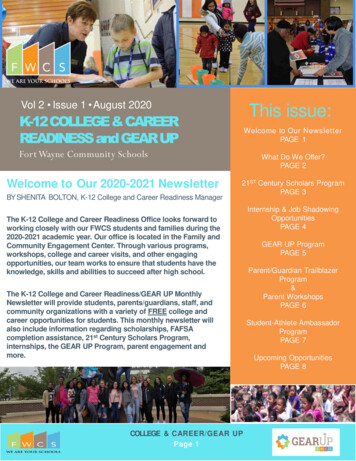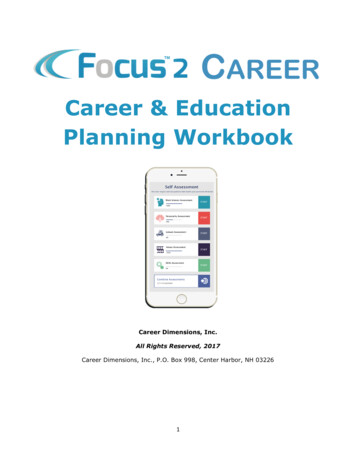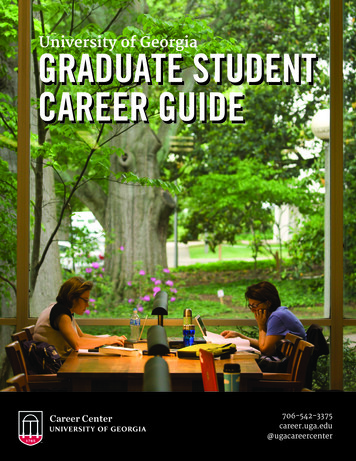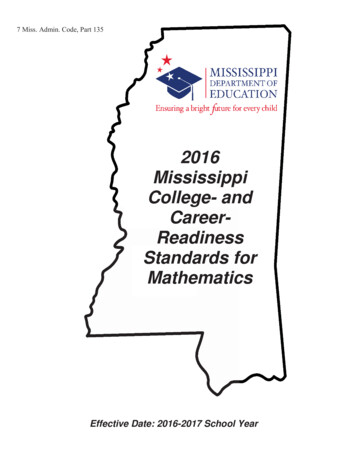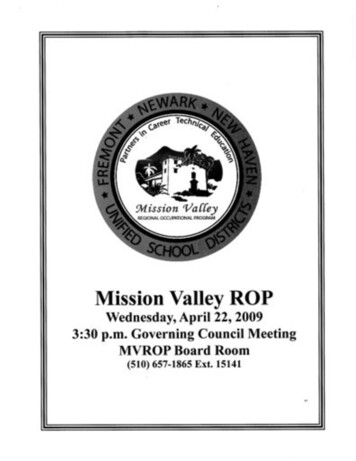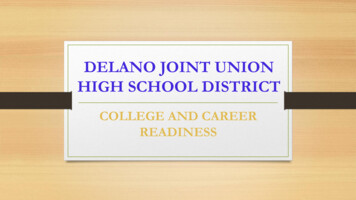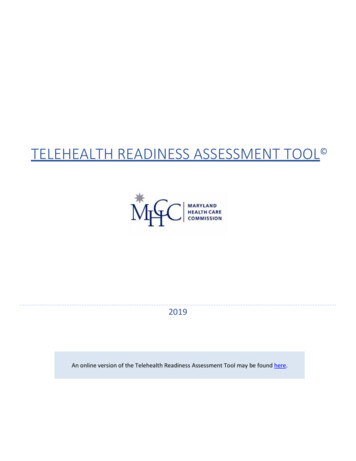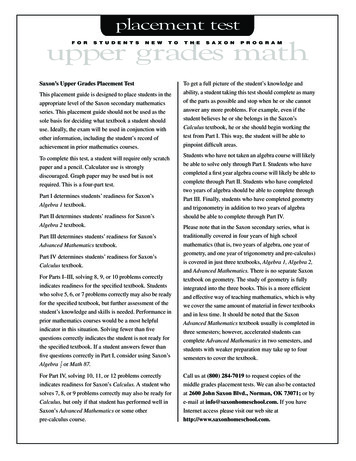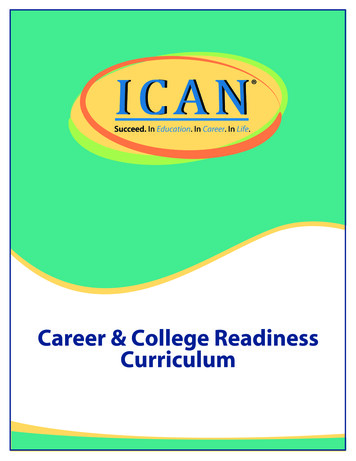
Transcription
Career & College ReadinessCurriculum
WICANhat toBringCurriculumTraining ManualCareer & College Readiness Supplemental CurriculumThe ICAN Curriculum Program takes the core ICAN programs and divides them into topic-specific lessonsthat can be adapted for grades nine through twelve. There are 24 lessons covering the full width of careerand college readiness, from entering high school to four-year plans, to financial literacy, selecting a college,and determining a college budget and financing plan.Each lesson goes in depth and engages students in discussion and activities to broaden their scope of whatit means to plan for life after high school . The goal is to enhance a school’s career and college readinessprogram with lessons that enhance curriculum already taking place and filling in any gaps that exist.The dividers in this manual provide a summary of lesson goals, as well as an outline of how the lessonshould flow, including suggested time frames for each section, and instructions on how to engage students.Many lessons have supplemental worksheets and handouts to further engage students and emphasizedthe message of the lesson.Each lesson has an assessment to be given as a pre- and post-test to gage comprehension and retention.Each lesson is designed to fit in a 45-50 minute lesson structure to fit both semester and trimesterscheduling. For block scheduling, multiple topics can be combined into a 90 minute lesson. Lessons fall intothe following categories: Career Preparation/Selection Academic Preparation Financial Literacy College Selection/ApplicationCurriculum LessonsCareer Preparation/Selection Life After High School - The Big Picture Career Assessment - Part 1 & 2 Job Shadows/Internships/Employability Exploring CTE Careers Exploring ApprenticeshipsAcademic Preparation Activities Resume Study Skills/Test Prep GPA /Foreign Language Social Media/Effective CommunicationsFinancial Literacy Student Debt Reality Basic Budgeting LifeStore Financial Literacy - Credit Internet Safety/Identity Theft Income Taxes Understanding Student LoansCollege Selection/Application College Comparisons College Course Planning Return on College Investment(ROCI) Scholarship Process - Part 1 Scholarship Process - Part 2 How to Apply College 101 Course Requirements Graduation vs AdmissionRequirements How is a college organized
LifeAftertoHighSchool:WhatBringThe Big PictureGrades: 9, 10,11,12Prerequisites: NoneLesson GoalThe goal of this lesson is to have students look at the next 40-50 years of their lives and gain a perspectiveof this “Big Picture”. Students will consider their high school years in connection with post-secondaryeducation along with a 40 year working career until retirement.What should students learn from the lesson? Students will learn why it is important to look at the “Big Picture” of their lives in terms of preparingfor post-secondary education and training, and their 40 year working career. Students will learn why post-secondary education and training is important to consider while inhigh school. Student will learn about how the choices they make now in high school can affect them in postsecondary education and training, and their work career.What is the in-class activity? The PowerPoint will drive the lesson with some slides presenting interactive questions reviewingmaterial and proposing thoughtful, engagement by students.What is the takeaway for students? It’s important to do some long range thinking “The Big Picture” Choices they are making now will impact their post-secondary options and their work career. Post-secondary education and training choices impact career options, financial security, and overalllifestyle after high school.Materials Needed: PowerPoint Projector Blank Paper/Pencil 2010-2021 ICAN ICAN is a 501(c)(3) nonprofit organization funded through donations, grants, and partnerships.
WCareerhat toBringAssessmentGrades: 9, 10,11,12Prerequisites: NoneLesson GoalThis lesson is recommended once per semester each year of high school. The goal of the Career Assessmentlessons are to engage students in discussion of likes, dislikes, skills, and interests, and how those personalitytraits impact career and college choices. The lesson will also delve into career research and begin discussionson career requirements for education and training after high school, high school course recommendations,and the influence of career choice on the overall college planning process.What should students learn from the lesson? Students will be able to list and rank career options as they relate to their interests. Students will be able to describe options after high school and why it matters to their careeraspirations. Students will be able to identify two realistic post-secondary options that will lead to the samecareer aspiration. Students will understand the role of high school courses in an overall post-high school plan.What is the in-class activity? Overview of Career Information System and setup of user account Completion of assessments Review of system website/portal and the assessment results Review of Career Cluster resultsand beginning of career selection and research Discussion of Career results including job outlook Discussion of recommended courses for career pathways Discussion of Education/Training results and requirements Creation of Career folder with copies of top career choices, career map and major map.What is the takeaway for students? Students will understand how their interests relate to career pathways and future occupationaloptions. Students will understand how career pathways link to potential college programs and majors. Students will understand what volunteer opportunities enhance experience and whatopportunities are available. Students will understand how academic performance can be directly correlated to goal attainment.Materials Needed: Computer Lab 2010-2022 ICAN ICAN is a 501(c)(3) nonprofit organization funded through donations, grants, and partnerships.
What MyACTto BringCareer AssessmentGrades: 9, 10,11,12Prerequisites: NoneLesson GoalThis lesson is recommended once per semester each year of high school. The goal of the MyACT lessons is toengage students in discussion of likes, dislikes, skills, and interests, and how those personality traits impactcareer and college choices. The lesson will also delve into career research and begin discussions on careerrequirements for education and training after high school, high school course recommendations, and theinfluence of career choice on the overall college planning process.What should students learn from the lesson? Students will be able to list and rank career options as they relate to their interests. Students will be able to describe options after high school and why it matters to their careeraspirations. Students will be able to identify two realistic post-secondary options that will lead to the samecareer aspiration. Students will understand the role of high school courses in an overall post-high school plan.What is the in-class activity? Overview of MyACT and setup of user account Completion of assessments Review of profile sections and tabs and the assessment results Review of Career Cluster Map and beginning of career selection and research Discussion of Career Map including job outlook Discussion of recommended courses for career pathways Discussion of Major Map and education and training requirements Creation of MyACT folder with copies of top career choices, career map and major map.What is the takeaway for students? Students will understand how their interests relate to career pathways and future occupationaloptions. Students will understand how career pathways link to potential college programs and majors. Students will understand what volunteer opportunities enhance experience and whatopportunities are available. Students will understand how academic performance can be directly correlated to goal attainment.Materials Needed: Computer Lab 2010-2021 ICAN ICAN is a 501(c)(3) nonprofit organization funded through donations, grants, and partnerships.
What to BringEmployabilityGrades: 10,11,12Prerequisites: Career AssessmentLesson GoalThe main goal of this lesson is to get students thinking about future careers they would like to ‘try on’ and togain an understanding of the ‘soft skills’ that increase your employability.What should student learn from the lesson? What job shadows and internships entail. Why it’s important to take part in a job shadow or internship. What employability soft skills include and why they are important.What is the in-class activity? Define Job Shadows Define Internships Discussion of why job shadows are important in high school. What benefits of job shadows include. Introduction of Intermediary Network and other places to find job shadows. When to do internships and how to find them. Define essential skills (eye contact, handshake, proper grammar/speech, appearance) Practice essential skills and interview questions with ICAN advisor and fellow students.What is the takeaway for students? Understand the difference between job shadows and internships. Know different resources to find and acquire job shadows and internships. Understand what soft skills are and why they are important. Have practiced essential skills and known the difference between good and bad skills. Have practiced interview skills and know how to structure answers to common interview questions.Materials Needed: Projector Discover Interests Worksheet Is It the Right Job Worksheet Employability Handout 2010-2021 ICAN ICAN is a 501(c)(3) nonprofit organization funded through donations, grants, and partnerships.
What toCTEBringExploringCareersGrades: 9, 10,11,12Prerequisites: Career AssessmentsLesson GoalThe goal of this lesson is to help students explore and understand career pathways that do not requirea four-year degree. This lesson explore registered apprenticeships and career and technical educationalopportunities.What should students learn from the lesson? Define and understand the importance of career and technical education Define education programs including Applied Science, Diplomas, and Certificates Available resources for career research and education assistanceWhat is the in-class activity? Watch introductory video Compare four-year and technical academic plans. Explore levels of training and career opportunities through CTE Match students with CTE programs according to interestsWhat is the takeaway for students? Students will know about Career and Technical Education programs and how to apply. Students will be matched with potential CTE programs leading to careers of interest. Students will know about scholarship programs and resources that help with CTE studies.Materials Needed: CTE Match Up Worksheet Computer lab or device with Internet Computer/Projector 2010-2021 ICAN ICAN is a 501(c)(3) nonprofit organization funded through donations, grants, and partnerships.
WhattoBringExploring ApprenticeshipsGrades: 9, 10,11,12Prerequisites: Career AssessmentsLesson GoalThe goal of this lesson is to help students explore and understand career pathways that do not requirea four-year degree. This lesson explore registered apprenticeships and career and technical educationalopportunities.What should students learn from the lesson? Define apprenticeship training programs Know which careers and industries utilize apprenticeship training Define union and employer-based apprenticeship programs Steps to beginning an apprenticeship or pre-apprenticeship programWhat is the in-class activity? Watch apprenticeship introductory video Discussion of earn and you learn programs Exploration ActivityWhat is the takeaway for students? Students will know about registered apprenticeship programs and the Earn As You Learn model.Materials Needed: ICAN Trades Guide (PDF or hard copy) Apprenticeship Exploration Worksheet Computer lab or device with Internet Computer/Projector 2010-2021 ICAN ICAN is a 501(c)(3) nonprofit organization funded through donations, grants, and partnerships.
WActivitieshat to BringResumeGrades: 9, 10,11,12Prerequisites: NoneLesson GoalThe lesson goal is to review the importance of involvement and for students to create an activities resume.Lesson outlines how to build a well-rounded activities resume and illustrates the benefits of a resume whenapplying for scholarships, admissions, employment, and as an aid for letters of recommendation.What should student learn from the lesson? The definition and use of an activities resume. The importance of volunteerism and how to find volunteer activities in Iowa. How to build a resume and arrange components. What makes a good resume stand out?What is the in-class activity? Define activities resume and have discussion of elements to be included and when andhow a resume can be used Using the ICAN template, students create a resume Review resumes and make edits where necessaryWhat is the takeaway for students? Students leave with a completed activity resume. Students understand the importance of having a resume and when to use the resume.Materials Needed: Computer Printer Copy of student’s GPA/transcript of academic achievements www.volunteeriowa.org/ 2010-2021 ICAN ICAN is a 501(c)(3) nonprofit organization funded through donations, grants, and partnerships.
WhatSkills/Testto BringPrepStudyGrades: 9, 10,11,12Prerequisites: NoneLesson GoalThe lesson goal is to empower students with study habits and skills to improve overall classwork and testscores, and to relieve some stress often accompanied by testing.What should student learn from the lesson? The importance of study skills and how to create an effective plan for test preparation. Effective note takingWhat is the in-class activity? Engage students in a discussion of current study habits Talk about effectiveness of current habits Engage students in a discussion of suggested habits and talk about why might be effective Discuss strategiesWhat is the takeaway for students? Students leave with a list of ways to improve study habits and prepare for tests with less stress. Students will learn strategies for test taking, test preparation, and note taking.Materials Needed: Paper and pencil 2010-2022 ICAN ICAN is a 501(c)(3) nonprofit organization funded through donations, grants, and partnerships.
What Pointto BAverageringGrade(GPA)Grades: 9, 10,11Prerequisites: NoneLesson GoalThis lesson is intended to help students understand what GPA is, how it is used, and why it is important inregard to high school and entering college.What should student learn from the lesson? What is grade point average? How is it calculated? Types of GPAs: unweighted vs. weighted How is a GPA used? Why is it important? Understand the “freshman trap” and avoid it. Why foreign language is an importance consideration.What is the in-class activity? The lesson will be driven by a PowerPoint that will serve as a reference anddirect the learning activities. Students will have time to give feedback as the lesson progresses to indicate their understanding. Set students up with elbow partners, small groups or as an entire class) Discussion of foreign language as a college admission and graduation requirement Discussion of the benefits of foreign language in high school.What is the takeaway for students? Realize what GPA is and its importance Avoid the “freshman trap” Understand the role foreign language plays in college admission and graduation.Materials Needed: GPA PowerPoint Foreign Language chart Projector Calculator GPA Worksheet 2010-2021 ICAN ICAN is a 501(c)(3) nonprofit organization funded through donations, grants, and partnerships.
MediaandWSocialhat toBringEffective CommunicationGrades: 9, 10,11,12Prerequisites: NoneLesson GoalThe goal of this lesson is for students to understand the difference between formal and informalcommunication and to be able to recognize and use the proper communication style in various forms ofcommunication. Students should also understand proper communication through Social Media and someof the consequences of improper communication through social media.What should student learn from the lesson? Students will understand the difference between formal and informal communication and will beable to identify each. Students will be able to write a formal letter and address an envelope for mailing. Students will know a simple way to use a cursive signature. Students will understand the importance of using appropriate tone and mode of communicationon social media. Students will understand the power of social media in positive and negative ways.What is the in-class activity?The PowerPoint will drive the lesson, but there are several opportunities for students to discuss and reportout from a pair or small group. There is also an activity to identify former and informal communicationin scholarship essays, an activity to engage students in writing a formal letter (thank you) and properlyaddress/stamp an envelope, and a communication wrap-up activity to show that students can match certainaspects of communication with the label “formal” or “informal.”What is the takeaway for students? It is important to know when formal communication is necessary and how impropercommunication can negatively affect impressions and decisions regarding students. It is important to know that the things students communicate, including on social media, havepositive and negative consequences in a student’s life – especially in making favorable impressionswith college staff or potential employers. Social media is a powerful tool that can be used for many positive experiences but can bemisused and inadvertently lead to negative impressions and experiencesMaterials Needed: PowerPoint Projector Pencils or Pens Handouts (Devices could be used for handouts and completed electronicaly) 2010-2021 ICAN ICAN is a 501(c)(3) nonprofit organization funded through donations, grants, and partnerships.
What to BringStudent Debt RealityGrades: 11,12Prerequisites: Career Assessment College ComparisonsLesson GoalThe main goal of this lesson is to educate students on the realities of paying for college, includingresponsible choices in student loans and the role career/major choice should play in the decision-makingprocess. The lesson provides an interactive activity demonstrating how student loan debt impacts all futurelife and financial opportunities and decisions.What should students learn from the lesson? Students will become aware of debt and the consequences of not borrowing responsibly. Students will learn to create a college budget and gain understanding of total college costs anddebt before selecting a college to attend. Analysis includes career choice and starting salary. Student will understand the correlation between student debt and future opportunities such asemployment, home ownership, marriage, children, and lifestyle. Students will become aware of the different factors that lead to over borrowing, and learn skills toborrow responsibly.What is the in-class activity? Utilizing their career assessment results, students will calculate their career-based recommendedborrowing limits Through a sample award letter scenario, students will analyze a scenario-based award pakcage anddetermine the best options to cover the remaining balance. Utilizing sample award letters and the College Funding Forecaster, students will analyze anaward package and determine if the student’s intended career path and recommended borrowinglimit fit in with the the overall out-of-pocket costs for the institution and the potential debt loadassociated with the choice. Group discussion will engage students throughout each step, as the class discusses each step of theprocess. At the end, students will discuss the award packages and the debt load their choices carryand further discuss the factors of their decision-making process.What is the takeaway for students? Student will have a better understanding of college debt and the steps to responsible borrowing.Materials Needed: Computer Compare College Costs worksheet Award Letter Samples Assessment Career List 2010-2021 ICAN ICAN is a 501(c)(3) nonprofit organization funded through donations, grants, and partnerships.
WhatBringBasictoBudgetingGrades: 9, 10,11,12Prerequisites: NoneLesson GoalThe main goal of this lesson is to educate the students on basic budgeting skills. Students that startunderstanding basic budgeting could possibly reduce the amount of loans they take out for college. Wewant students to have a grasp on simple budgeting concepts. By learning these concepts hopefully theycan apply them to their daily lives.What should students learn from the lesson? What is a budget and what is included in a budget How to create a budget The importance of having a budget Understanding the term “living within our means”What is the in-class activity? Talk about budgeting/ask students what a budget entails. Add retirement chart! Use the Mastering the Money Game worksheet, or go over worksheet and have themcreate their own for in present time and in college. Go through 3 examples of students and talk about pros and cons of both Student#1: follows no budget Student#2: follows somewhat of a budget Student#3: follows a budgetOpen discussion throughout lesson with interactive board work. End discussion will include benefits ofbudgeting and long-term budget goals including marriage, kids, home purchase, and retirement.What is the takeaway for students? Students will know how to set up a budget for bills and personal expenses. Students will understand basic budgeting concepts and rewards of budgeting. Students will understand the difference between a ‘want’ and a ‘need’.Materials Needed: Mastering the Money Game worksheet/kit Computer/Projector Everydollar.com Mint.com 2010-2021 ICAN ICAN is a 501(c)(3) nonprofit organization funded through donations, grants, and partnerships.
WhatLifetoStoreBringGrades: 9, 10,11,12Prerequisites: NoneLesson GoalFor students to experience and understand the monthly budgeting of a household and making financialdecisions with a set income and responsibilities.What should students learn from the lesson?Students will learn about the day to day decisions of running a family budget. They will come to understandthe difference between a want and a need. They will understand how much things cost, how a monthlyincome can be quickly consumed by monthly bills, and how education/training, marriage, and kids allimpact household finances.What is the in-class activity?Life Store is an interactive budgeting activity that simulates life decisions including housing, transportation,child care, and more based upon an assigned family status and career. Students will have a budgetworksheet and they will work through monthly financial decisions for their sample family status and mustend the month with a positive balance in their checking account.After each student or group of students have completed their budget, a class discussion will be heldabout how they feel about the activity, about the decisions they made and about what they learned aboutbudgeting and finances. Timeframe is adaptable but needs minimum of 45 minutes. Introduction and setup (5 minutes) Budget Activity (45-60 minutes) Summary Discussion (10-15 minutes)What is the takeaway for students?1. To understand the importance of budgeting2. To understand monthly responsibilities3. To understand the importance of planning4. To understand how money is intertwined into every aspect of life, and that planning from an earlyage provides the most opportunity for successMaterials Needed: LifeStore Budget Worksheets LifeStore Kit (if not using pre-filled worksheets) Pencils Calculator 2010-2021 ICAN ICAN is a 501(c)(3) nonprofit organization funded through donations, grants, and partnerships.
WhatLiteracy:to BringFinancialCreditGrades: 11,12Prerequisites: NoneLesson GoalThe lesson goal is to inform students of the importance of credit and to provide an understanding of howcredit works.What should students learn from the lesson? Students will learn what ‘credit’ is, how it is tracked. Student will understand the importance of credit reports and scores. Student will learn about credit cards and how best to utilize them in building good credit.What is the in-class activity? Lead by PowerPoint, students will engage in a discussion of credit, credit reports,credit scores, and how credit impacts everyday life. Students will go through a credit card statement and learn about minimumpayments vs higher payments. Students will work through sample credit scenarios such as buying a car, lookingat options for both good and bad credit. Students will work through a sample credit report and engage in discussion ofgood and bad credit decisions.What is the takeaway for students? Students will understand the role credit plays in life decisions. Students will know how to find their credit report and score. Students will understand how the decisions the make can impact their credit, and thereby impactfuture opportunities including employment, home ownership, and loans.Materials Needed: Computer Credit Report Samples 2010-2021 ICAN ICAN is a 501(c)(3) nonprofit organization funded through donations, grants, and partnerships.
IdentityWhatto BTheft/ringInternet SafetyGrades: 9, 10,11,12Prerequisites: NoneLesson GoalIdentity theft and safety on the Internet are concerns for students in high school and as they proceed onto college. This lesson will seek to raise awareness of some of the issues on this topic as well as presentsuggested safeguards to help protect students from these threats.What should students learn from the lesson? Student will learn what identity theft is and different types Students will learn about dangers to be aware of on the Internet. Students will learn about particular safeguards they should practice to protect themselves againstidentity theft and Internet dangers. Students will learn about Internet predators, their common characteristics, how they operate, andsafeguards to protect themselves. Students will learn about the role of social media in employment and college admissions, as well asthe dangers of social media and how to safeguard one’s privacy.What is the in-class activity?The PowerPoint will drive the lesson with slides presenting interactive questions reviewing material andproposing thoughtful engagement by students on Internet, privacy, and social media. Students will beencouraged to share their own experiences and to engage in discussion and debate of the role in Internetin a safe society. Part of the discussion will include a true story of Internet and technology responsibility andthe consequences of not safeguarding one’s privacy and devices.What is the takeaway for students? The Internet is a great tool but has its dangers. Students need to learn to protect themselves in regard to identity theft. Students need to use responsible behaviors when using the Internet that will help protectthem especially as they go to college.Materials Needed: PowerPoint Projector Copy of “A True Story” Sound or Speakers for the Video 2010-2021 ICAN ICAN is a 501(c)(3) nonprofit organization funded through donations, grants, and partnerships.
Whatto BringIncomeTaxGrades: 10,11,12Prerequisites: NoneLesson GoalMore and more students are working to earn income to cover both personal and college expenses. Thislesson will provide basic knowledge of how income taxes work and will help the student file a basic 1040form as well as give them good background in completing the financial information section of the FAFSA.What should student learn from the lesson? Students will learn what the Pay-As-You-Go income tax system is about. Students will come to understand the purposes of the W-4 and W-2 forms for income tax. Students will learn how to complete a 1040 form for income tax.What is the in-class activity? The PowerPoint will drive the lesson. It will address some of the major teaching points. On Checking for Understanding slides, ask the question and have students respond based onprevious slides. The lesson finishes with a tax return simulation. Make sure students have a copy of the 1040form. Walk them through the parts of the simulation using the PowerPoint.What is the takeaway for students? Students will understand tax refunds and will understand why it is in theirbest interest to file a tax return. A better understanding of taxes in relation to financial aid and the FAFSA.Materials Needed: PowerPoint on Income Tax 1040 form Projector Sample W-4 Sample W-2 2010-2021 ICAN ICAN is a 501(c)(3) nonprofit organization funded through donations, grants, and partnerships.
WUnderstandinghat to BringStudent LoansGrades: 11,12Prerequisites: Return on CollegeInvestment (ROCI)Lesson GoalThe goal of this lesson is to inform students about the entire student loan process. Students will learn abouthow student loans work and the steps they will need to take use the student loan amount.What should students learn from the lesson? Students will learn about the Stafford Loan offered by the federal government through FederalStudent Aid. Students will learn about the steps they will need to take to apply and carry out the loan process. Students will learn about private student loans and available loan sources. Students will learn about paying back student loans and about the return on college investment asit relates to borrowing.Wha
Review of Career Cluster resultsand beginning of career selection and research Discussion of Career results including job outlook Discussion of recommended courses for career pathways Discussion of Education/Training results and requirements Creation of Career folder with copies of top career
